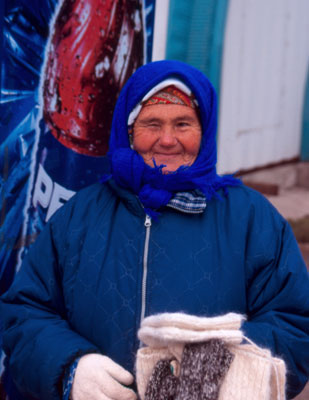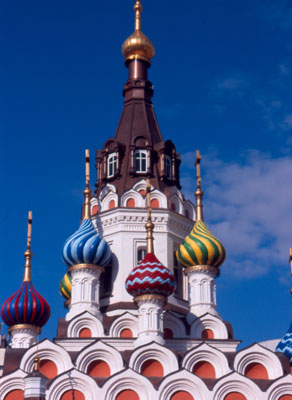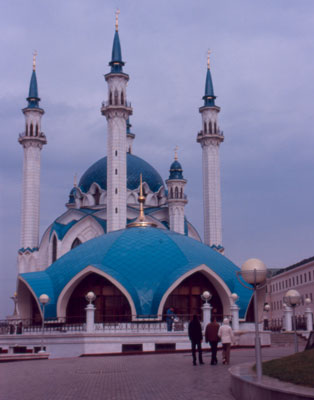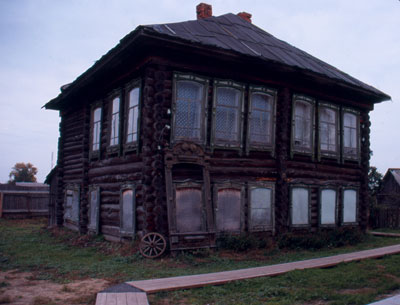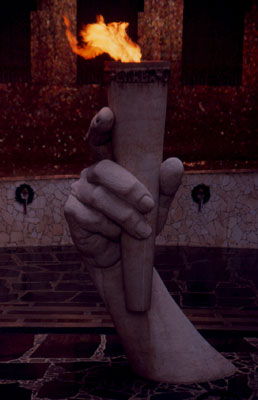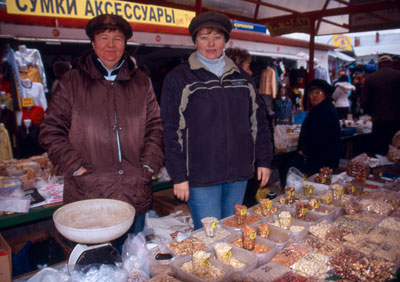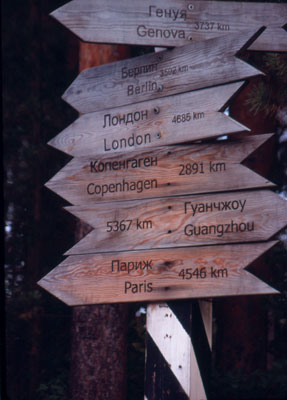Exploring the remote villages of Russia's Southern Urals
In my continuing quest to visit every oblast (region) of Russia, I landed in Moscow in September ’08 to join six other travelers arriving by various flights from every direction within the continental United States. Our group spent one night in Moscow, then flew on to Ekaterinburg, where we were joined by Paul Schwartz, our MIR Corp. tour manager, to begin our adventure in earnest.
Ekaterinberg
Ekaterinberg is clean, modern and full of life. It is commonly known as the place where the last czar, Nicholas II, and his family were imprisoned and executed by the Bolsheviks, but it is also the city where Boris Yeltsin began his political career.
As with most Russian cities, Ekaterinberg has many monuments and statues. The most dramatic and moving of these is the “Black Tulip,” a bronze of an exhausted, traumatized soldier sitting on the ground holding his rifle. It captures the frustration, suffering and hopelessness suffered by the troops sent to Afghanistan in the last years of Soviet power.
Just west of the city, we visited the marker on the border of Asia and Europe, straddling the line so that we stood on both continents simultaneously.
Worth seeing was the Church on the Blood, built over the spot where the Romanov family was executed in July 1918. We also visited the monastery complex that stands on the site of the mine shaft where their bodies had been burned and dumped. The site contains seven beautiful chapels constructed of logs in the traditional Russian style, each representing one royal family member.
The area is also famous for its mineral wealth, and we enjoyed seeing the 2,000-plus minerals on exhibit in the Urals Mineralogical Museum.
On to Siberia
Over the next few days we covered about 1,500 miles, traveling in a comfortable Mercedes van. We developed a real appreciation for a territory rarely visited by outsiders. Most of the cities we visited had been closed to foreigners before the Soviet breakup.
Our first day’s drive, to Tyumen, took us by the field where Gary Powers had landed after his U-2 was shot down during the Cold War. Soon after, we passed a large concrete monument marking our arrival into Siberia.
Tyumen is a prosperous city and the capital of the Tyumen Oblast, which provides more than 90% of the country’s oil and gas. It is also the oldest Russian city in Siberia.
Our afternoon was spent on a city tour. That night, we had the first of our visits to a family home for dinner. It was one of the highlights of the trip.
The entire family spoke English to some degree. Besides providing a delicious dinner, they had prepared entertainment and games for us. Their warm hospitality and sincere interest in us made for an unforgettable evening.
The next morning we drove to the tiny village of Pokrovskoye to visit the Rasputin Museum. Rasputin’s home was torn down long ago, but the museum, housed in an old log cabin, re-creates it and contains many of the “Mad Monk’s” personal belongings.
Other items of interest were a book on Rasputin edited by Saddam Hussein and numerous commercial items, from soap to beer, branded with the Rasputin name. A Rasputin look-alike made an appearance, posing for photos with members of our group.
We continued our drive to Kurgan, notable because it’s not mentioned in the Lonely Planet guidebook. Founded in 1553, it is one of the oldest settlements in Siberia and has a pre-Scythian history. It is a stop on the Trans-Siberian Railroad and had been a key city in the Soviet scientific and industrial communities.
In the morning we took a city tour, which included a very nice, informative museum.
We continued through the countryside to Chelyabinsk, a large industrial city on the eastern slope of the Ural Mountains. Since it had begun as a stop on the Silk Road, its symbol is the camel.
Chelyabinsk was the home of the Soviet Katyusha rocket and T-34 tank during WWII, earning it the nickname “Tankograd.” As in all the cities we visited, traffic was extremely heavy, the current affluence of the society reflected in the number of new luxury cars packing the streets, including Hummer stretch limos.
This city, as most we visited, boasted international ethnic restaurants and modern malls with upscale shopping. Prices seemed to be comparable to what we would pay at home.
Into the countryside
After a full day in Chelyabinsk, we took an overnight train on a spur of the Trans-Siberian Railroad to Ufa, crossing the Urals back into Europe. We occupied a new, very comfortable first-class car, arriving early in the morning.
Ufa is the capital of the Republic of Bashkortostan and is a major industrial center. It was founded in 1574 by Ivan the Terrible but had been occupied by Turkic-speaking Bashkirs and Tatars before that. Currently, of the million people living there, 36% are Russian, 30% Bashkir and 24% Tatar.
Here we saw the first of many mosques we would see in the following days. We enjoyed our tour of the city, experiencing our first light snowfall and clean, invigorating air.
Our drive the next day was another highlight for most of us. Crossing the midlands of Russia, we were impressed by its vastness as well as the richness of its farmland. For most of the morning we traveled through breathtaking scenery.
This area has extensive oil deposits, and we saw countless “nodding donkey” pump jacks in the fields, working continuously but not detracting from the beauty of the countryside. More eye-catching were the many thick forests, their trees in the fullness of fall colors — vibrant yellows interspersed with oranges and reds.
We noted many signs indicating that the forests were protected and urging care for the animals and the environment. Where the trees had been cleared for farming, the soil was black and rich.
Our drive was a continuous panorama of brilliantly hued trees and fields interspersed with lovely, colorful villages characterized by their old Russian wooden architecture and minarets. The houses were brightly painted in vivid colors, most commonly mustard yellow, burnt orange and green, with shutters and intricately carved trim painted royal or sky blue.
Each village felt timeless, as if it had existed quaintly forever, a little treasure nestled in the rolling hills of this very beautiful region.
After a night in Naberezhnye Chelny, the second-largest city in Tatarstan, we proceeded to Kazan, the capital of the region and another city with a very old history. It is the farthest point west that Genghis Khan’s Golden Horde conquered. Ivan the Terrible defeated the Mongol Tatars there in 1552 and built a beautiful cathedral that is now the oldest building in the Kazan Kremlin (fortress), a UNESCO World Heritage Site.
Both Russian Orthodox Christians and Muslims have lived together peacefully in Kazan for over 500 years. It is now a vibrant, prosperous city.
Our evening meal in a family home was another highlight. These home visits, where we met and interacted with average citizens, provided insight into Russian home life far beyond what we could experience in our casual encounters with hotel and restaurant personnel as well as vivid memories to be cherished for years to come.
Volga cruise
The following day we boarded the MS Sholokhov for a pleasant 6-day cruise down the lower Volga River. The cruise took us to five Russian cities and through beautiful countryside.
Between the cities, the banks of the river were often covered with forests in the fullness of their fall colors. Fishermen in small boats contributed to the idyllic, peaceful scenery.
Up to this point, the weather had been overcast and cold, but once we were on the river an Indian summer gave us warm, sunny days.
Our first stop was in the midsized city of Ulyanovsk, the birthplace of Vladimir Lenin. His childhood home is now a museum. It was obvious from the home’s many rooms and furnishings that his had been a wealthy family.
The following day we toured Samara, another prosperous city and the home of the Samara car and many other manufactured goods. Stylish boutiques line the main shopping street.
This is the city where Lenin practiced his entire, unsuccessful law career, chiefly notable because he never won a case. It is also the home of Zhigulevskoe beer and a chocolate factory, and it boasts Russia’s oldest permanent circus.
We took an optional, fascinating tour to Stalin’s secret bunker, only discovered in 1990. He never occupied it and there is no evidence that he even visited it, but we felt it was well worth seeing.
That evening, as the sun set and we continued our cruise down the Volga, we were treated to a piano concert of classics played by a prize-winning pianist — a fitting ending to another fulfilling, pleasant day.
Remembering war
The following day, we stopped at Saratov. Yuri Gagarin had studied there, and his capsule had landed in a nearby field after he made history as the first man in outer space.
The following day was spent in Volgograd, formerly Stalingrad, our first Hero City and the site of the turning point of WWII. Hitler had lost no major battles before his defeat there and won none thereafter. The Battle of Stalingrad virtually destroyed the city, claiming hundreds of thousands of lives.
Not surprisingly, the city commemorates this battle with innumerable statues and monuments. The War is not something from the distant past here but a presence that still touches its citizens’ lives.
We visited the Mamaev Kurgan, a dominant viewpoint overlooking the city. Defense of this hill exacted extremely high casualties from the Soviets. Even today, fragments of bone can still be discovered on the site.
At its summit is an enormous, dramatic statue, “The Motherland Calls,” with sword upheld. When it was built in 1967 it was the largest free-standing sculpture in the world, and it must be seen to be appreciated. Below it, built into the hill, is a rotunda where a giant hand holds a torch with an eternal flame guarded by somber soldiers.
Later we visited another must-see location, the city’s war museum, where the reality of war and its devastation were portrayed. Our group was quiet and subdued after our city tour due to the seriousness of the sites we had visited.
Our local guide had lived through the battle. Her simple words, without any drama, self-pity or rancor, made a huge impact on us. I felt a tremendous gratitude that I had never had to deal with such a thing. As is so often true with travel, what we experienced that day gave us a renewed appreciation for our own lives, our own country and the times we live in.
In spite of the modernity seen in its many trendy shops and restaurants, the entire city of Volgograd is a poignant memorial to the War and the countless lives lost as it raged.
One last day
After a day cruising down the river, we arrived at Astrakhan, the center of the “chessboard” where the Great Game (the Anglo-Russian “war” for control of the Orient) was played out. From this base, Russia launched many expeditions into the Caucasus and beyond. Tamerlane burned the city in 1395 and it was conquered by Ivan the Terrible in 1556.
We saw many centuries-old buildings during our city tour, including the beautiful Ascension Cathedral, built in the early 1700s, in Astrakhan’s kremlin.
In the afternoon we drove out of the city to a hunting and fishing camp where the Volga splits into many smaller branches to form its delta on the Caspian Sea. We loaded into three small fishing boats and spent the next two hours speeding to the sea and back.
The banks on either side were brilliant with fall colors. We saw huge stands of lotus, no longer in bloom, and many birds, including gulls and groups of white swans.
After returning to the fishing camp, we were treated to an incredible feast to cap another highlight of our trip. The following day we flew back to Moscow before returning home.
Summing up
All the cities we visited contained a pleasant mixture of old and new. Very old buildings housed new Internet cafés. Signs in English competed with those in Cyrillic Russian.
On park benches, elderly babushkas bundled in scarves, heavy cloth coats and thick socks watched as fashionable young women in spike heels, tight jeans and trendy jackets hastened by.
How much longer these cities will keep their old charm is anyone’s guess. As we saw, bustling traffic and cell phones were everywhere. McDonald’s and Baskin-Robbins were only two of the American franchises that have become common.
Twenty-four-hour modern grocery stores were also abundant. Modern freeways and luxury-car dealerships have sprouted up like mushrooms. To all appearances, capitalism is alive and well in Russia, and it has dramatically improved the standard of living of the average citizen.
Trip arrangements
I had planned our itinerary in conjunction with MIR Corporation in Seattle (800/424-7289, www.mircorp.com), who had made all the arrangements. As usual, they did an outstanding job with our accommodations, local guides, family visits, sites and restaurants.
The trip was a perfect mix of history, architecture, scenery, culture, people, activities and leisure time. Paul (in the group’s opinion, the best tour manager ever) took excellent care of each of us and our individual needs while helping us experience Russia and the Russian people in a way that few Americans ever do.
The cost for my 20-day tour was just under $9,000, including round-trip air from Moscow, accommodations and most meals.
Many travelers take the Trans-Siberian Railroad from Moscow to Vladivostok and think that they “know” Russia. Perhaps they do, in the same superficial way that a person would “know” the USA after taking Amtrak from San Francisco to Chicago.
What a difference it made when we visited little-known cities, drove through the vast, beautiful countryside and had meals in people’s homes. I am grateful to MIR Corp. and Paul for helping us to experience more of Russia and its people in such a meaningful, memorable way, and I look forward to the next time we travel with them.


